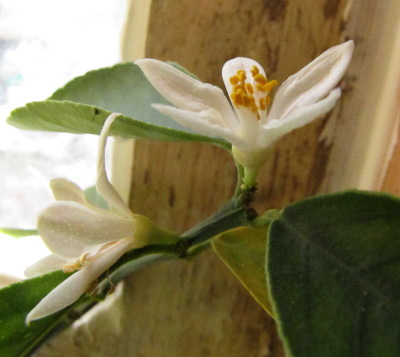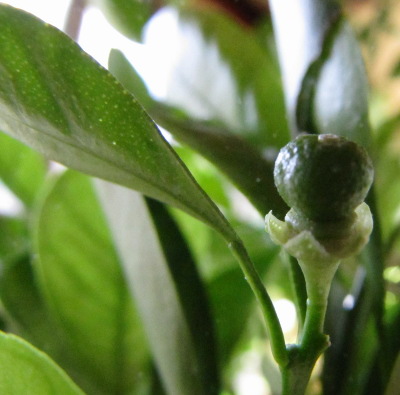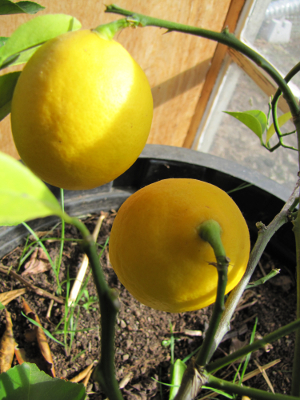
Dwarf citrus blooms and fruits
 Now
for the fun part --- blooming! I suspect that some people get
dwarf Meyer lemons for the beauty and fragrance of the blooms alone,
not even caring about the fruits. Other dwarf citrus plants have
similar, but less showy, flowers, and the information below applies to
all of the common species.
Now
for the fun part --- blooming! I suspect that some people get
dwarf Meyer lemons for the beauty and fragrance of the blooms alone,
not even caring about the fruits. Other dwarf citrus plants have
similar, but less showy, flowers, and the information below applies to
all of the common species.
Meyer lemons can bloom
throughout the year, but they tend to bloom the
most in the winter, as do most other dwarf citrus trees. That
presents a problem since there are no bees flying around your living
room to pollinate the flowers. I've found that some flowers will
self-pollinate (especially if you shake the tree a bit), but you'll get
more fruits if you take a few minutes to hand-pollinate each new batch
of blooms.
 The flowers are ready to be
pollinated when the pistil (green part in
the middle of the flower) is shiny and the petals are lush and
white. Simply take a small paintbrush (or your fingertip) and
gently tap the stamens of one flower to gather pollen, then tap the
pistil of another flower to fertilize that fruit. You'll have to
repeat this procedure a few times over the course of the bloom since
flowers open in stages, and some have already lost their petals (too
late to pollinate) by the time the last ones have opened.
The flowers are ready to be
pollinated when the pistil (green part in
the middle of the flower) is shiny and the petals are lush and
white. Simply take a small paintbrush (or your fingertip) and
gently tap the stamens of one flower to gather pollen, then tap the
pistil of another flower to fertilize that fruit. You'll have to
repeat this procedure a few times over the course of the bloom since
flowers open in stages, and some have already lost their petals (too
late to pollinate) by the time the last ones have opened.
Another option --- but
one I can't recommend --- is to open your window
during a sunny winter day and let your honeybees in. We did this
last year because our worker bees could smell the flowers' aroma
through the
screen and wanted in for such a luscious winter treat. The bees
pollinated our tree beautifully, but couldn't figure out how to get
back outside, and several perished.
 No matter how you pollinate
the
flowers,
you'll know you've been
successful if the flowers drop their petals but maintain the green
ovary in the center. The tree will naturally thin itself,
dropping perhaps 75% of its flowers within a few days of full
bloom. Citrus trees generally go through a second round of
thinning a few weeks later when the fruits are pea- to
marble-sized. After this second thinning, you may choose to thin
a bit further so that there's no more than one fruit in each cluster.
No matter how you pollinate
the
flowers,
you'll know you've been
successful if the flowers drop their petals but maintain the green
ovary in the center. The tree will naturally thin itself,
dropping perhaps 75% of its flowers within a few days of full
bloom. Citrus trees generally go through a second round of
thinning a few weeks later when the fruits are pea- to
marble-sized. After this second thinning, you may choose to thin
a bit further so that there's no more than one fruit in each cluster.
Then you wait, and wait,
and wait. Our dwarf Meyer lemon
generally takes about eight months to ripen its fruits, which gives us
lemons in November or December. You can tell the fruits are ripe
by color (Meyer lemons should actually turn slightly orange) and by the
lift test --- gently lift a fruit upwards, and if the fruit is ripe it
will snap off the branch without any force on your part. Give one
fruit a taste and then pick the others if that one was juicy and sweet.
I won't bother to tell
you what
to do with the fruits.
They go
far too fast because they're so delicious. That's when you have
to be careful not to buy five more dwarf citrus trees, requiring you to
kick your kids out to take over their sunny room.
| This post is part of our Dwarf Citrus lunchtime series.
Read all of the entries: |
Want more in-depth information? Browse through our books.
Or explore more posts by date or by subject.
About us: Anna Hess and Mark Hamilton spent over a decade living self-sufficiently in the mountains of Virginia before moving north to start over from scratch in the foothills of Ohio. They've experimented with permaculture, no-till gardening, trailersteading, home-based microbusinesses and much more, writing about their adventures in both blogs and books.
Want to be notified when new comments are posted on this page? Click on the RSS button after you add a comment to subscribe to the comment feed, or simply check the box beside "email replies to me" while writing your comment.

Debbi --- To be honest, I often don't pollinate either and get fine results. I hear people on the internet arguing for and against the need to pollinate, and I suspect it might just depend on how much movement happens around your plant. Do the cats walk by, is there a ceiling fan, or are the plants hidden away in a still corner? If the latter, pollination is probably more essential.
Daddy --- Does your other citrus bloom and not bear fruit or just not bloom?
Hello,
I live in a coastal town with lots of fog, but I bought a new dwarf Meyer lemon tree at a store right down the street last week. It is covered with lovely white flowers and even has two fruits dangling already. I've had it for five days and the petals are suddenly brown. They aren't falling off, but they're all brown and I'm really sad. What did I do wrong?
Thanks!